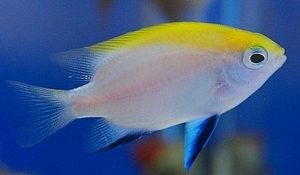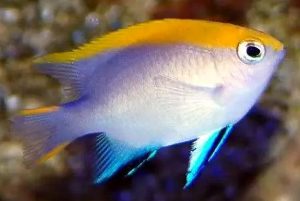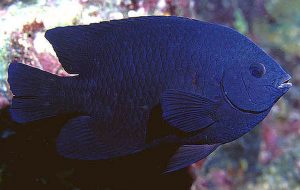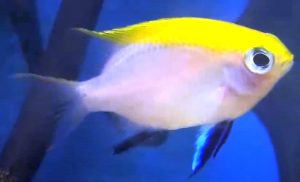Bluefin Damselfish (Neoglyphidodon melas) known to tropical fish keeping enthusiasts as the Black Damselfish, Bowtie Damselfish, Yellow-back Damsel, and Royal Damsel is found among coral reefs and lagoons throughout the Indo West Pacific.
In the Indian Ocean; Bluefin Damselfish are widely distributed around eastern Africa, the Red Sea, the Persian Gulf, Madagascar, the Seychelles, the Arabian Sea, Sri Lanka, the Maldives, the Andaman Sea, Indonesia, and western Australia.
In the Pacific Ocean they are found in many areas around Australia, Indonesia, Japan, Papua New Guinea, Palau, the Philippines, the Solomon Islands Taiwan, Vanuatu, and Vietnam.
Bluefin Damselfish are usually found swimming individually or in pairs at depths from 3 to over 120 feet among soft corals on which they feed in the coral reefs and lagoons of their range. The more solitary adult and young adult Neoglyphidodon melas are frequently found swimming among Tridacna clams where they have been observed feeding on their feces. Feces consumption is believed to increase with age and size.
The more colorful younger juveniles are usually encountered in small groups or as lone individuals around Acropora corals where they feed solely on plankton. Older juvenile Bluefin Damselfish include soft corals in their planktonic diet, which is why they are not particularly considered reef safe.
Juvenile Bluefin Damselfish are much more attractive than adults. They have a mostly pale blue gray body color
with a bright yellow upper back and dorsal area. The pelvic and anal fins are blue with black interior rays, and the rear portion of the dorsal fin and the caudal fin are translucent. As the fish mature into adulthood, their body turns a uniformly bluish black color.
Bluefin Damselfish are best housed in a mature FOWLR semi aggressive species tank or in a single species tank of at least 55 gallon capacity, with a sand or finely crushed coral substrate and plenty of live rock arranged into hiding places for them to hide among and lots of swimming area.
Smaller juveniles are semi aggressive but as they mature into adulthood, they become increasingly aggressive to smaller individuals and other peaceful fish in the tank. Adults’ should be kept alone or with other large aggressive species.
Large Bluefin Damselfish will attack fish much larger than themselves. Because they feed on soft corals, pose a threat to shrimp and other invertebrates, and harass Tridacna clams; they are not recommended for reef aquariums.
Bluefin Damselfish have been commercially bred for the aquarium trade. They pair up for breeding and follow a benthic egg laying cycle. The male cleans an area on the substrate for the female to lay her adhesive, demersal eggs and after a brief courtship ritual, the female will deposit her eggs on the substrate. The male then fertilizes the eggs and will guard and aerate them until the larvae hatch out. The fry in their larval stage will drift with the current as plankton feeding on zooplankton and phytoplankton before settling to the bottom as partially developed damselfish.
As juveniles, Bluefin Damselfish feed on small crustaceans, microalgae, and zooplankton. As adults, their diet changes to soft corals and Tridacna clam feces.
In an aquarium environment they will accept most foods and should be fed a varied diet of meaty items along with some vegetable matter. Live, frozen, or freeze dried brine shrimp, Mysis shrimp
, chopped clams, fresh fish, and Spirulina flakes
will all be eagerly accepted. Feeding a varied diet several times a day is recommended.
Bluefin Damselfish (Neoglyphidodon melas) are occasionally available to tropical fish keeping enthusiasts as juveniles and occasionally adults. Many fish shops can special order them or they can be purchased online from wholesalers, trans shippers, and retailers at prices varying from $12.99 to the $20.00 range at the following approximate purchase sizes: Small: 3/4″ to 1-1/4″; Medium: 1-1/4″ to 2″.
Care Level: Easy
Temperament: Aggressive
Color Form: Black, Blue, Yellow
Diet:Omnivore
Origin: Indo-Pacific, Red Sea, Vanuatu
Reef Compatible: No
Water Conditions: sg 1.020-1.025, 72-78° F, dKH 8-12, pH 8.1-8.4
Max. Size: 7.1″
Family: Pomacentridae
Minimum Tank Size: 55 gallons
Lifespan: 2-3 years






